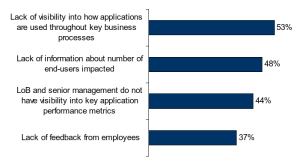
Aberdeen’s research shows a 16 percent increase in the number of organizations that are satisfied with the performance of business-critical applications since March of 2008.
However, the disparity among respondents is profound. Ninety-three percent of Best-in-Class organizations are satisfied with their application performance, and only 48 percent of Industry Average and Laggard organizations show the same level of satisfaction. Even though the research shows a significant increase in the adoption of tools and services for application performance management, nearly half of organizations surveyed are still struggling when trying to find the right approach for managing the performance of business-critical applications. This comes as a result of the following trends:
- Managing application performance is no longer a problem shouldered by IT departments alone, but is becoming an issue that requires the involvement of business management.
- Optimizing application performance cannot be achieved solely by deploying technology solutions.
Figure 1 shows that the inability to map the use of applications to the workflows of business processes that are leveraging these applications is the top obstacle for evaluating the business impact of performance issues. The research also shows that 48 percent of organizations do not have visibility into how many users are being impacted by performance issues.
 Figure 1: Top Obstacles for Evaluating the Business Impact of Issues With Application Performance (click on image to enlarge)
Figure 1: Top Obstacles for Evaluating the Business Impact of Issues With Application Performance (click on image to enlarge)Impact on Business Performance
This creates a risk for end-user organizations to invest in solutions that would help them improve application performance, but not necessarily the business performance. The research shows that 34 percent of organizations surveyed increased their budgets for improving application performance. However, these organizations were looking to optimize only 36 percent of the applications that they considered business-critical. Since nearly half of these organizations did not have the ability to evaluate the impact of application performance on their business goals, it became very difficult for them to calculate the true return on application performance investments they were making.
Aberdeen data shows that improving the usability of application performance information is the top strategic action that Best-in-Class organizations are taking to improve application performance management. Additionally, even though the inability to prevent performance issues before end-users are impacted is the top challenge for managing application performance, 37 percent of Industry Average and Laggard organizations are still not managing application performance beyond the production stage.
Testing application performance in the development and predeployment stages helps end-users to be more proactive and eliminate bottlenecks before applications are rolled out on the network. The research shows that Best-in-Class organizations are 62 percent more likely to be managing application performance beyond the production stage as compared to all others (Industry Average and Laggard companies combined).
However, it should be noted that this is not the only strategy organizations need to take to mitigate the disruption of business processes due to issues with application performance. Having full visibility into how applications are performing in production allows them to optimize their networks for optimal application performance. Organizations can effectively improve the usability of application performance information only if they can achieve the following goals:
- Deliver the right performance data to the right job roles and at the right time.
- Discover performance bottlenecks before applications are rolled out on the network
Best-in-Class Capabilities
Best-in-Class organizations are nearly four times more likely to provide executives with visibility into application performance metrics as compared to Laggards. Having this capability in place allows organizations to translate operational performance metrics — such as application availability and application and transaction response times — into business goals such as customer satisfaction, cost savings and revenue growth. Having this capability in place contributed to Best-in-Class organizations being twice as likely to improve their ability to accurately prioritize IT problems as compared to Laggards.
Interestingly, survey respondents that came from the business side of the organization were 32 percent more likely to report that this was a capability that they were interested in deploying over the next two years as compared to IT-related job roles. This shows a certain level of concern from IT staff that their business executives would be looking “over their shoulders” when it came to managing application performance. However, Best-in-Class organizations have a completely opposite view. These organizations are providing executives with visibility into application performance to insure that the business side of an organization is aware of the business impact of performance issues. This helps their IT staff justify investments in additional capabilities for application performance management.
List of Recommendations
The following actions will help spur the necessary performance improvements:
- Laggard:
- Develop capabilities for eliminating application performance issues in the predeployment stage.
- Deploy tools for prioritizing and controlling network traffic.
- Average:
- Develop capabilities for providing executives with visibility into the business impact of application performance.
- Deploy tools for application load testing.
- Best-in-Class:
- Map business-critical applications to key business processes.
- Develop capabilities for measuring application performance from the end-user perspective.
To access a complimentary copy of the full benchmark, click here.
Bojan Simic is a senior research analyst in telecommunications at the Aberdeen Group.















































